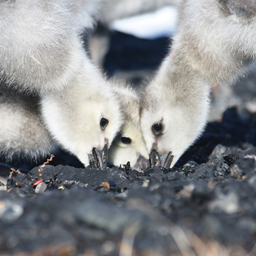Pollution poses threat to Arctic goose
Polluted air, water and land can have a far-reaching effect on animals in polar regions. An international team led by Isabella Scheiber, Maarten Loonen and Jan Komdeur from the University of Groningen and including researchers from the universities of Leipzig, Vienna and Wageningen and the University of Groningen Arctic Centre has shown that heavy metals in the ground in Svalbard affect the physiological processes of barnacle goslings (Branta leucopsis) and lead to stress. Their findings have been published in the journal Proceedings of the Royal Society B.

Over 50 years ago, a coal mine imploded close to Ny-Ålesund in Svalbard. Although the village was cleaned up, the area around the deserted mine, which is used as a grazing area by a population of barnacle geese, was not. Previous research by a team led by Maarten Loonen had already shown that high levels of heavy metals (trace elements) are still present in the area around the deserted mine. These can accumulate in the goose’s body as it grazes. It is known that pollution can affect animal behaviour, and in stressful situations, such as an encounter with a predator, the right behaviour can mean the difference between life and death. The researchers set out to discover the effect of heavy metals on the physiology and behaviour of barnacle goslings in acute stress situations.
Stress hormones
The research team studied barnacle goslings that spent the first days of their lives grazing by the polluted mine or on clean grounds. They measured the level of a stress hormone in the goslings’ droppings and observed their response to a stress test that consisted of isolating the goslings from their families for a short period of time or limiting their freedom. The goslings that grazed by the polluted mine were more restless and had higher levels of the stress hormone in their blood than their siblings that had grazed in the clean areas.
Survival
This research shows that past pollution persists for a long period of time and can significantly affect an animal’s stress response. Jan Komdeur: ‘We were astounded because the goslings were exposed to the pollution for an extremely short period of time. However, this was during a critical phase in their development. The long-term effect of this early exposure to trace elements, on reproduction success and the survival of the barnacle goose for example, remains to be seen. In fragile ecosystems such as the polar regions, this effect could be crucial to the species.’
More information
- Publication: Scheiber, I.B.R., Weiß, B.M., de Jong, M.E., Braun, A., van den Brink, N.W., Loonen, M.J.J.E., Millesis, E. & Komdeur, J. - Stress behaviour and physiology of developing Arctic barnacle goslings (Branta leucopsis) is affected by legacy trace contaminants . Proceedings of the Royal Society of London. Series B, Biological Sciences, 285: 20181866.
| Last modified: | 25 February 2022 08.29 a.m. |
More news
-
03 April 2025
IMChip and MimeCure in top 10 of the national Academic Startup Competition
Prof. Tamalika Banerjee’s startup IMChip and Prof. Erik Frijlink and Dr. Luke van der Koog’s startup MimeCure have made it into the top 10 of the national Academic Startup Competition.
-
01 April 2025
NSC’s electoral reform plan may have unwanted consequences
The new voting system, proposed by minister Uitermark, could jeopardize the fundamental principle of proportional representation, says Davide Grossi, Professor of Collective Decision Making and Computation at the University of Groningen
-
01 April 2025
'Diversity leads to better science'
In addition to her biological research on ageing, Hannah Dugdale also studies disparities relating to diversity in science. Thanks to the latter, she is one of the two 2024 laureates of the Athena Award, an NWO prize for successful and inspiring...
